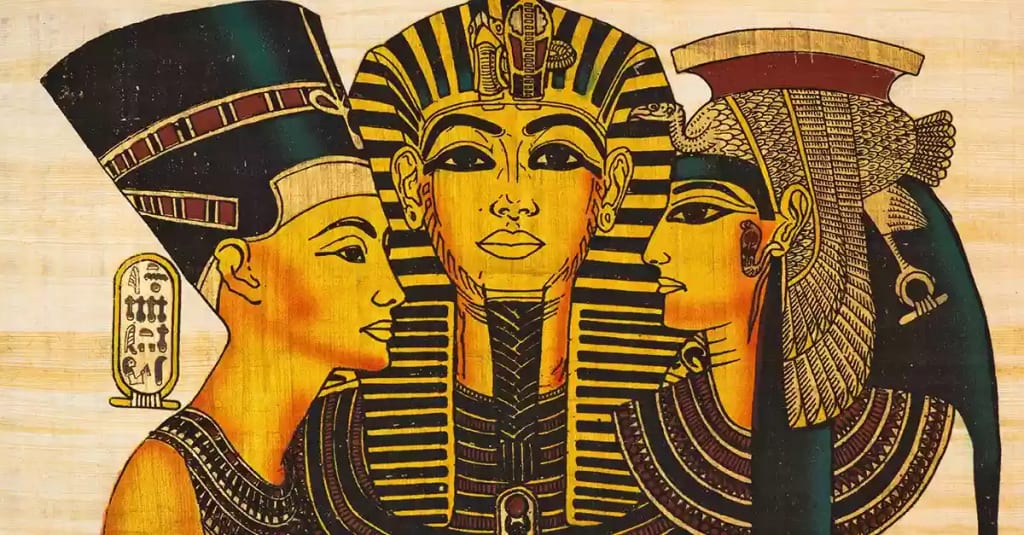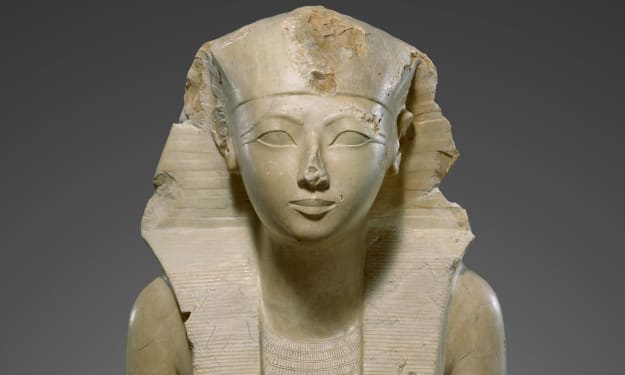From Tutankhamun to Cleopatra: Discovering the Astounding Achievements of Ancient Egypt's Greatest Pharaohs
Introduction to Ancient Egypt's greatest pharaohs

Ancient Egypt, with its rich history and captivating culture, is known for its impressive pharaohs who ruled the land during different eras. These pharaohs were not only powerful leaders but also visionaries who left an indelible mark on the world. In this article, we will delve into the extraordinary achievements of some of Ancient Egypt's greatest pharaohs, including Tutankhamun, Ramses II, Nefertiti, and Cleopatra. Let us embark on a journey through time to explore the remarkable legacies they have left behind.
Tutankhamun: Unraveling the mysteries of the boy king
Tutankhamun, often referred to as the "boy king," ascended to the throne at the tender age of nine. Despite his short reign, lasting only around ten years, Tutankhamun's tomb, discovered by British archaeologist Howard Carter in 1922, has provided unparalleled insights into the opulence and grandeur of Ancient Egypt. The treasures found within the tomb, including the iconic golden mask that adorned Tutankhamun's mummy, have captivated the world. Through careful analysis of the artifacts, archaeologists have pieced together a fascinating narrative of the young pharaoh's life and the religious beliefs of the time.
Tutankhamun's reign may have been brief, but his impact on Egypt's history is immeasurable. His death at a young age remains shrouded in mystery, with theories ranging from illness to foul play. Nevertheless, Tutankhamun's tomb and the treasures it held shine a light on the artistic and technological advancements of Ancient Egypt's New Kingdom. It serves as a testament to the immense wealth and power of the pharaohs, offering a glimpse into their incredible achievements.
The reign of Ramses II: Egypt's longest-serving pharaoh
Ramses II, also known as Ramses the Great, is one of the most renowned pharaohs in the history of Ancient Egypt. His reign lasted an astonishing 66 years, during which he left an indelible mark on the kingdom. Ramses II was a prolific builder, leaving behind numerous architectural wonders that still stand today. The temples of Abu Simbel, with their colossal statues carved into the rock, are a testament to his grandeur and the power of Ancient Egypt.
Beyond his architectural achievements, Ramses II was also a skilled military strategist. He led successful campaigns against the Hittites and expanded Egypt's territories. His diplomatic prowess was evident in the signing of the world's first known peace treaty, the Treaty of Kadesh, which brought an end to the conflict between Egypt and the Hittite Empire. Ramses II's rule was characterized by prosperity and stability, making him one of the most influential pharaohs in Ancient Egyptian history.
Nefertiti: The iconic queen who challenged gender norms
Nefertiti, whose name means "the beautiful one has come," was a queen who defied traditional gender roles and left an enduring legacy in Ancient Egypt. She was the wife of Pharaoh Akhenaten and played a significant role in the religious and cultural revolution of the Amarna period. Nefertiti's portrayal in art, with her elegant and regal features, has made her an iconic figure in Egyptian history.
As queen, Nefertiti held immense power and influence, often depicted alongside her husband in official ceremonies and religious rituals. She was an active participant in the Aten cult, a monotheistic religion that worshipped the sun disc, Aten. Nefertiti's role in promoting this new religious ideology challenged the established pantheon of Ancient Egypt, making her a symbol of change and innovation.
Despite her prominence during her lifetime, Nefertiti's ultimate fate remains a mystery. Some speculate that she may have assumed the role of pharaoh following her husband's death, while others believe she disappeared from historical records altogether. Regardless, Nefertiti's beauty, intellect, and influence continue to fascinate and inspire people around the world.
Cleopatra: Egypt's last pharaoh and her influential rule
Cleopatra, the last pharaoh of Ancient Egypt, is perhaps one of the most famous figures in history. Known for her beauty, intelligence, and political acumen, Cleopatra's reign marked the end of the Ptolemaic dynasty and the beginning of Roman rule in Egypt. Her relationship with Roman leaders, particularly Julius Caesar and Mark Antony, has been the subject of countless tales and legends.
Cleopatra's rule was marked by a strategic alliance with Rome, which allowed her to maintain Egypt's independence. She was an astute diplomat and skilled linguist, fluent in multiple languages, which enabled her to negotiate with foreign powers and further her kingdom's interests. Cleopatra's influence extended beyond politics; she was also a patron of the arts and sciences, fostering a cultural renaissance during her time.
Despite her remarkable achievements, Cleopatra's downfall came with the defeat of her forces by Octavian, later known as Emperor Augustus. Rather than face capture and humiliation, Cleopatra took her own life, forever cementing her legacy as a symbol of resilience and defiance in the face of adversity. Her story continues to captivate the world, inspiring countless works of literature, art, and film.
The architectural wonders of ancient Egypt
Ancient Egypt is renowned for its awe-inspiring architectural wonders that have stood the test of time. The pyramids of Giza, built as tombs for pharaohs, are among the most recognizable and enduring structures in the world. These monumental structures showcase the incredible engineering skills of the ancient Egyptians, who meticulously planned and constructed these immense edifices.
In addition to the pyramids, ancient Egypt boasts numerous temples dedicated to gods and goddesses. The Temple of Karnak, with its towering columns and intricate reliefs, is a testament to the grandeur of Egyptian religious architecture. The Mortuary Temple of Hatshepsut, designed as a tribute to the female pharaoh, is a masterpiece of design and innovation.
The ancient Egyptians' architectural achievements were not limited to grand tombs and temples. They also developed sophisticated irrigation systems, such as the qanat, to harness the power of the Nile River for agriculture. The use of hieroglyphics in their architectural designs added a unique artistic element to their structures, further showcasing their mastery of both form and function.
The legacy of ancient Egypt's greatest pharaohs
The legacy of Ancient Egypt's greatest pharaohs extends far beyond their lifetimes. Their remarkable achievements continue to shape our understanding of history, culture, and even modern society. The pyramids, for example, have inspired countless architects and engineers, serving as a testament to the human capacity for ingenuity and perseverance.
Ancient Egyptian art and iconography have influenced artists throughout the ages, from the Renaissance to the present day. The symbolism and motifs found in their artwork, such as the Eye of Horus and the Ankh, have become synonymous with Egypt's rich cultural heritage. The preservation of these ancient artifacts and the ongoing archaeological discoveries have allowed us to piece together the puzzle of Ancient Egypt's past and gain insight into their society and beliefs.
Moreover, the pharaohs' impact on modern culture is evident in various aspects of our daily lives. From fashion trends inspired by ancient Egyptian aesthetics to the fascination with mummies and curses, their influence permeates popular culture. The allure of Ancient Egypt continues to capture the imagination of people worldwide, fueling a desire to explore and learn more about this ancient civilization.
Uncovering the secrets of ancient Egyptian burial practices
The ancient Egyptians' beliefs about the afterlife played a significant role in their burial practices. They believed in the preservation of the body to ensure a successful journey into the afterlife. The process of mummification, which involved removing internal organs, desiccating the body, and wrapping it in linen bandages, was a complex and meticulous procedure.
The Book of the Dead, a collection of spells and rituals, was placed alongside the deceased to guide them through the perilous journey of the afterlife. Elaborate tombs and burial chambers were constructed to house the bodies and provide them with all the necessary provisions and comforts. The pharaohs, in particular, were buried with immense wealth and treasures, symbolizing their divine status and power.
The discovery of Tutankhamun's tomb in the 20th century provided unprecedented insights into the elaborate burial practices of the ancient Egyptians. The meticulously preserved artifacts, including funerary masks, golden sarcophagi, and treasures from daily life, revealed the intricate rituals and beliefs surrounding death and the afterlife. These discoveries continue to amaze and educate us about the customs and beliefs of this ancient civilization.
The impact of ancient Egyptian pharaohs on modern culture
Ancient Egyptian pharaohs have left an indelible mark on modern culture, influencing various aspects of art, literature, and even fashion. The fascination with Ancient Egypt has persisted throughout the centuries, captivating the imaginations of people around the world. From the iconic golden mask of Tutankhamun to the enigmatic smile of the Sphinx, these ancient artifacts have become iconic symbols of an intriguing and mysterious past.
The influence of ancient Egyptian art can be seen in various art movements, such as Art Deco and Art Nouveau, which drew inspiration from the geometric forms and stylized figures of Egyptian hieroglyphics. In literature, authors have been inspired by the tales of Cleopatra's allure and the grandeur of the pharaohs' reigns, weaving these stories into their own narratives.
Moreover, the fashion industry has been captivated by the timeless elegance and regal aesthetics of ancient Egypt. From the use of Egyptian motifs in jewelry to the incorporation of flowing silhouettes and vibrant colors reminiscent of Egyptian attire, the influence of this ancient civilization can be seen on runways and in wardrobes worldwide.
Conclusion
Ancient Egypt's greatest pharaohs were visionary leaders who left an extraordinary legacy that continues to captivate and inspire us today. From Tutankhamun's golden treasures to Cleopatra's political prowess, their achievements have shaped our understanding of history and influenced various aspects of modern culture. The architectural wonders they left behind, such as the pyramids and temples, serve as testaments to their engineering prowess and artistic sensibilities.
The secrets of ancient Egyptian burial practices and the impact of these pharaohs on modern society continue to be unearthed through ongoing archaeological discoveries. The allure of Ancient Egypt, with its mystique and grandeur, remains as strong as ever, drawing people from all corners of the globe to explore its rich history.
As we embark on this journey through time, let us marvel at the astounding achievements of Ancient Egypt's greatest pharaohs and appreciate the enduring legacy they have left behind. Their stories remind us of the power of human ingenuity, resilience, and the pursuit of knowledge. Let us continue to explore and learn from the wonders of this ancient civilization, keeping their memory alive for generations to come.





Comments
Lane Montgomery is not accepting comments at the moment
Want to show your support? Send them a one-off tip.